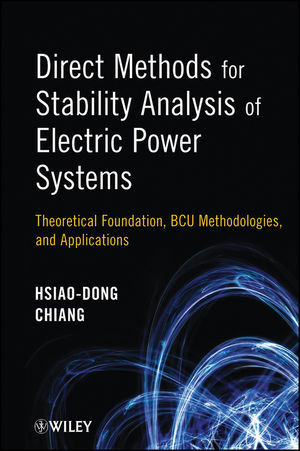Direct Methods for Stability Analysis of Electric Power Systems: Theoretical Foundation, BCU Methodologies, and ApplicationsISBN: 978-0-470-48440-1
Hardcover
512 pages
December 2010
 This is a Print-on-Demand title. It will be printed specifically to fill your order. Please allow an additional 10-15 days delivery time. The book is not returnable.
|
||||||
Acknowledgments.
1. Introduction and Overview.
1.1 Introduction.
1.2 Trends of Operating Environment.
1.3 Online TSA.
1.4 Need for New Tools.
1.5 Direct Methods: Limitations and Challenges.
1.6 Purposes of This Book.
2. System Modeling and Stability Problems.
2.1 Introduction.
2.2 Power System Stability Problem.
2.3 Model Structures and Parameters.
2.4 Measurement-Based Modeling.
2.5 Power System Stability Problems.
2.6 Approaches for Stability Analysis.
2.7 Concluding Remarks.
3. Lyapunov Stability and Stability Regions of Nonlinear Dynamical Systems.
3.1 Introduction.
3.2 Equilibrium Points and Lyapunov Stability.
3.3 Lyapunov Function Theory.
3.4 Stable and Unstable Manifolds.
3.5 Stability Regions.
3.6 Local Characterizations of Stability Boundary.
3.7 Global Characterization of Stability Boundary.
3.8 Algorithm to Determine the Stability Boundary.
3.9 Conclusion.
4. Quasi-Stability Regions: Analysis and Characterization.
4.1 Introduction.
4.2 Quasi-Stability Region.
4.3 Characterization of Quasi-Stability Regions.
4.4 Conclusions.
5. Energy Function Theory and Direct Methods.
5.1 Introduction.
5.2 Energy Functions.
5.3 Energy Function Theory.
5.4 Estimating Stability Region Using Energy Functions.
5.5 Optimal Schemes for Estimating Stability Regions.
5.6 Quasi-Stability Region and Energy Function.
5.7 Conclusion.
6. Constructing Analytical Energy Functions for Transient Stability Models.
6.1 Introduction.
6.2 Energy Functions for Lossless Network-Reduction Models.
6.3 Energy Functions for Lossless Structure-Preserving Models.
6.4 Nonexistence of Energy Functions for Lossy Models.
6.5 Existence of Local Energy Functions.
6.6 Concluding Remarks.
7. Construction of Numerical Energy Functions for Lossy Transient Stability Models.
7.1 Introduction.
7.2 A Two-Step Procedure.
7.3 First Integral-Based Procedure.
7.4 Ill-Conditioned Numerical Problems.
7.5 Numerical Evaluations of Approximation Schemes.
7.6 Multistep Trapezoidal Scheme.
7.7 On the Corrected Numerical Energy Functions.
7.8 Concluding Remarks.
8. Direct Methods for Stability Analysis: An Introduction.
8.1 Introduction.
8.2 A Simple System.
8.3 Closest UEP Method.
8.4 Controlling UEP Method.
8.5 PEBS Method.
8.6 Concluding Remarks.
9. Foundation of the Closest UEP Method.
9.1 Introduction.
9.2 A Structure-Preserving Model.
9.3 Closest UEP.
9.4 Characterization of the Closest UEP.
9.5 Closest UEP Method.
9.6 Improved Closest UEP Method.
9.7 Robustness of the Closest UEP.
9.8 Numerical Studies.
9.9 Conclusions.
10. Foundations of the Potential Energy Boundary Surface Method.
10.1 Introduction.
10.2 Procedure of the PEBS Method.
10.3 Original Model and Artifi cial Model.
10.4 Generalized Gradient Systems.
10.5 A Class of Second-Order Dynamical Systems.
10.6 Relation between the Original Model and the Artifi cial Model.
10.7 Analysis of the PEBS Method.
10.8 Concluding Remarks.
11. Controlling UEP Method: Theory.
11.1 Introduction.
11.2 The Controlling UEP.
11.3 Existence and Uniqueness.
11.4 The Controlling UEP Method.
11.5 Analysis of the Controlling UEP Method.
11.6 Numerical Examples.
11.7 Dynamic and Geometric Characterizations.
11.8 Concluding Remarks.
12. Controlling UEP Method: Computations.
12.1 Introduction.
12.2 Computational Challenges.
12.3 Constrained Nonlinear Equations for Equilibrium Points.
12.4 Numerical Techniques for Computing Equilibrium Points.
12.5 Convergence Regions of Equilibrium Points.
12.6 Conceptual Methods for Computing the Controlling UEP.
12.7 Numerical Studies.
12.8 Concluding Remarks.
13. Foundations of Controlling UEP Methods for Network-Preserving Transient Stability Models.
13.1 Introduction.
13.2 System Models.
13.3 Stability Regions.
13.4 Singular Perturbation Approach.
13.5 Energy Functions for Network-Preserving Models.
13.6 Controlling UEP for DAE Systems.
13.7 Controlling UEP Method for DAE Systems.
13.8 Numerical Studies.
13.9 Concluding Remarks.
14. Network-Reduction BCU Method and Its Theoretical Foundation.
14.1 Introduction.
14.2 Reduced-State System.
14.3 Analytical Results.
14.4 Static and Dynamic Relationships.
14.5 Dynamic Property (D3).
14.6 A Conceptual Network-Reduction BCU Method.
14.7 Concluding Remarks.
15. Numerical Network-Reduction BCU Method.
15.1 Introduction.
15.2 Computing Exit Points.
15.3 Stability-Boundary-Following Procedure.
15.4 A Safeguard Scheme.
15.5 Illustrative Examples.
15.6 Numerical Illustrations.
15.7 IEEE Test System.
15.8 Concluding Remarks.
16. Network-Preserving BCU Method and Its Theoretical Foundation.
16.1 Introduction.
16.2 Reduced-State Model.
16.3 Static and Dynamic Properties.
16.4 Analytical Results.
16.5 Overall Static and Dynamic Relationships.
16.6 Dynamic Property (D3).
16.7 Conceptual Network-Preserving BCU Method.
16.8 Concluding Remarks.
17. Numerical Network-Preserving BCU Method.
17.1 Introduction.
17.2 Computational Considerations.
17.3 Numerical Scheme to Detect Exit Points.
17.4 Computing the MGP.
17.5 Computation of Equilibrium Points.
17.6 Numerical Examples.
17.7 Large Test Systems.
17.8 Concluding Remarks.
18. Numerical Studies of BCU Methods from Stability Boundary Perspectives.
18.1 Introduction.
18.2 Stability Boundary of Network-Reduction Models.
18.3 Network-Preserving Model.
18.4 One Dynamic Property of the Controlling UEP.
18.5 Concluding Remarks.
19. Study of the Transversality Conditions of the BCU Method.
19.1 Introduction.
19.2 A Parametric Study.
19.3 Analytical Investigation of the Boundary Property.
19.4 The Two-Machine Infi nite Bus (TMIB) System.
19.5 Numerical Studies.
19.6 Concluding Remarks.
20. The BCU–Exit Point Method.
20.1 Introduction.
20.2 Boundary Property.
20.3 Computation of the BCU–Exit Point.
20.4 BCU–Exit Point and Critical Energy.
20.5 BCU–Exit Point Method.
20.6 Concluding Remarks.
21. Group Properties of Contingencies in Power Systems.
21.1 Introduction.
21.2 Groups of Coherent Contingencies.
21.3 Identifi cation of a Group of Coherent Contingencies.
21.4 Static Group Properties.
21.5 Dynamic Group Properties.
21.6 Concluding Remarks.
22. Group-Based BCU–Exit Method.
22.1 Introduction.
22.2 Group-Based Verifi cation Scheme.
22.3 Linear and Nonlinear Relationships.
22.4 Group-Based BCU–Exit Point Method.
22.5 Numerical Studies.
22.6 Concluding Remarks.
23. Group-Based BCU–CUEP Methods.
23.1 Introduction.
23.2 Exact Method for Computing the Controlling UEP.
23.3 Group-Based BCU–CUEP Method.
23.4 Numerical Studies.
23.5 Concluding Remarks.
24. Group-Based BCU Method.
24.1 Introduction.
24.2 Group-Based BCU Method for Accurate Critical Energy.
24.3 Group-Based BCU Method for CUEPs.
24.4 Numerical Studies.
24.5 Concluding Remarks.
25. Perspectives and Future Directions.
25.1 Current Developments.
25.2 Online Dynamic Contingency Screening.
25.3 Further Improvements.
25.4 Phasor Measurement Unit (PMU)-Assisted Online ATC Determination.
25.5 Emerging Applications.
25.6 Concluding Remarks.
Appendix.
A1.1 Mathematical Preliminaries.
A1.2 Proofs of Theorems in Chapter 9.
A1.3 Proofs of Theorems in Chapter 10.
Bibliography.
Index.



